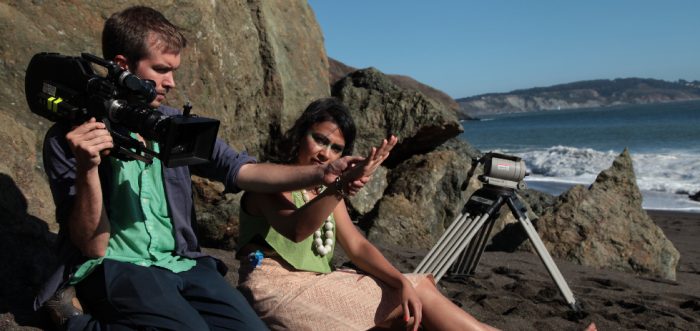In a pop landscape increasingly oblivious to the traditional demarcation of high and low culture, the work of filmmaker Michael Robinson occupies a unique and fascinating space. Drawing on fields as varied as experimental film, music video, and soap opera to reshape them into new forms, Robinson both interrogates and celebrates the debris of pop culture with an intellectual and formal rigor that doesn’t betray the work’s essential emotional sensation. His films are simultaneously familiar and unexpected, playful and terrifying, and assembled with a magic sensibility that suggests almost occult transcendence. From the cosmically (and comically) deranged Full House breakdown Light is Waiting to the aesthetically overwhelming These Hammers Don’t Hurt Us—which ingeniously posits Elizabeth Taylor and Michael Jackson as interdimensional travelers—his films approach cultural memory and the slipperiness of nostalgia from thrilling angles.
Robinson’s new film Mad Ladders—which he describes as “A modern prophet’s visions of mythical destruction and transformation… recounted across a turbulent geometric ceremony of rising curtains, swirling set pieces, and unveiled idols from music television’s past”—was unveiled at the New York Film Festival and plays, through January 16, as part of an exhibition of his work at Chicago’s Carrie Secrist Gallery. I spoke with him recently about the new film, his work, inspirations, and the time the divine manifested itself in Pee-Wee’s Playhouse.
For those who’ve yet to see it, just to clarify—Mad Ladders isn’t an adaptation of the Super Mario game.
Mad Ladders is not an adaptation of the Mario game, though it does feature an 8-bit soundtrack, and involves some warped aspirations of ascension and transformation. It’s a woozy, funny collage, guided by an impassioned voice, rolling clouds, and heavily-processed passages from the American Music Awards telecasts of the 1980s and ’90s.
Why the AMAs, and how many hours of footage did you look at? Was there one performance that stayed with you from your first viewing?
The film began a few years ago, when I was looking through a lot of Whitney Houston-related material, thinking I might make a piece using her many entrances and exits from stages and sets. Her performance of “All at Once” from the 1987 AMAs started my fascination with the show’s elaborate staging. As the music begins, a patterned curtain rises to reveal Houston walking downstage in silhouette as a formation of three large triangular sculptures move gracefully around her, all while the camera zooms steadily inward. The triangles are pink with black-and-white checkerboard accents, the background shifts from deep magenta to lime green, and Houston’s angular ’80s pantsuit is bright white. I started thinking a lot about how these technical choreographies of stage and camera factor into the mythologising of their subjects and the mesmerizing of their audiences. I wanted to treat this as a somewhat lost and elegant art form, in contrast to the ubiquity of digital screens and flying multi-camera capture that stands in its place today. This stylisation wasn’t contained to just the AMAs, but it seemed central to the program’s identity in a way that wasn’t true of the era’s other awards shows. I managed to get all of the telecasts from 1980-1994 on fan-made DVDs, and watched or scrubbed my way through 15 years of the program.
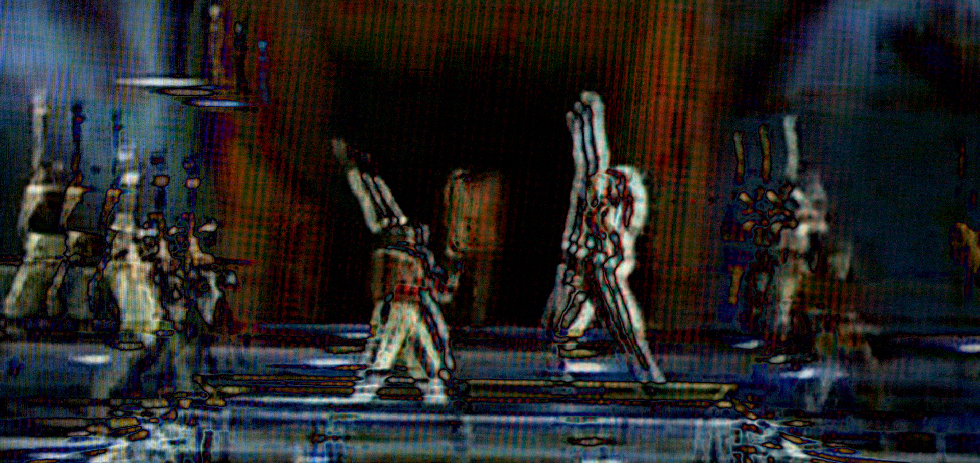
Is the narration “found sound” or specifically written and recorded for the piece?
It’s all pulled from the YouTube channel of a Christian “prophet” from the southern US, who posts daily audio recordings of her visions and dreams. I love her voice, and her stories are beautifully deranged. I edited out all of the specific religious names and references (of which there are many) to retain just the fantastical, mythological elements of her storytelling.
The voice-over seems to frame these performers as gods, or god-like people, and there’s a mixture of adoration and fear/betrayal in her account. I can relate, because as a kid these shows seemed so far away and so unreal. What was the experience like for you, watching these at a young age? And did that feed into your ideas for this film?
My interest in the show itself doesn’t derive from childhood associations, as I honestly don’t know if I ever watched it as a kid (I’m sure I did at some point). However, the music and the stars of the ’80s were very influential to my childhood, so the show still resonates for me in the realm of the formative.
Mad Ladders feels almost of a piece with These Hammers Don’t Hurt Us—or at least echoes it, visually (the pyramids/awards stages, the choreographed dance) and in terms of our relationship to the deities of pop music. Were there any conscious parallels for you?
Definitely. I think of it as a sibling to both These Hammers Don’t Hurt Us and Line Describing Your Mom, both of which also look at theatricality and spirituality through their fractured, surreal narrations. A friend said that Mad Ladders feels like an origin story for the worlds and characters of my other films, which I think is fitting. Michael and Liz don’t turn up in this one, but Diana Ross “appears” three times, and Janet Jackson twice.
The film’s pathway to the sun also resonates with your short feature, Circle in the Sand. Do you see the ending to Ladders connecting with the wandering tribe in Circle at all?
I hadn’t thought of that… but both films do deal with society resetting itself, in one way or another, and the waving figures at the end of Mad Ladders are sitting in a circle, in the sand. So, yes.
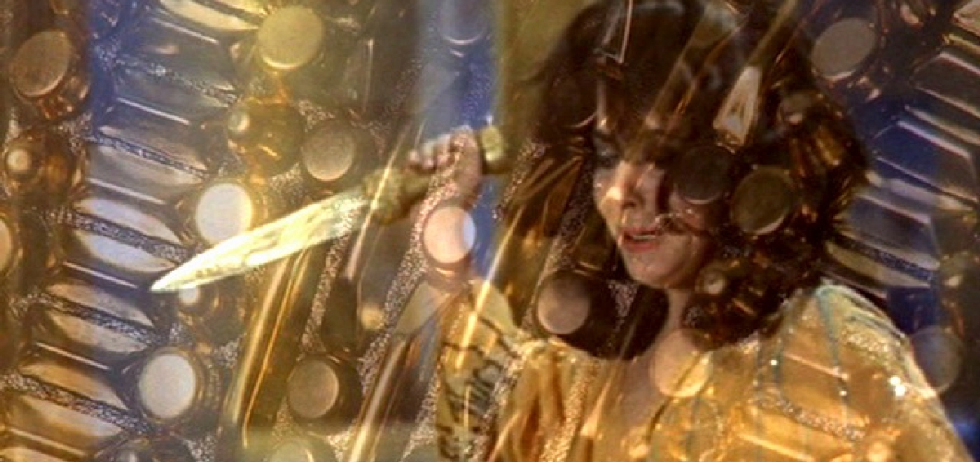
These Hammers Don’t Hurt Us was an immensely affecting experience for me when I first saw it—there’s an unexpected, transcendent beauty to it. It isn’t a response audiences might traditionally associate with “experimental” pieces, yet a lot of your films achieve that state, whether it’s by tapping a collective pop nostalgia or making us confront the slipperiness of memory. Are you aiming for a certain kind of audience response with the work? Does Hammers hold any personal meaning for you?
It’s personal in that it was shaped by my sensibilities, but I don’t intentionally project my life or myself onto my films in any direct way. These Hammers Don’t Hurt Us deals with life and death and legacy in (I think) a pretty heartfelt and accessible way, so the overall effect can be very personal. When I’m putting a film together, I aim to satisfy and surprise myself first and foremost, and assume that once something works for me, it will work for audiences too. But in almost all of my work, there’s an intentional push and pull between disorientation and familiarity, and a definite investment in conjuring intense emotions, even if it’s unclear what exactly the conjured emotions are… emotional abstraction, in a sense. I trust that the signifiers or triggers in the film—whether they are pop cultural, or mythological, or whatever —hold both obvious, surface-level connotations, and more residual, subconscious ones. Arranged within a film, they can operate through and across one another, in a kind of atmospheric web of associations. Liz Taylor is Cleopatra is Liz Taylor is Hollywood is Egypt is Isis is 30BC is 1963 is Liz Taylor is 2010 is alive is dead is alive, etc.
You said that Hammers originated from an obsession with Michael Jackson’s Dangerous, which has always been the record of his that fascinated me most—partly because it catches him at that moment of transformation, physically and musically, and it because it’s such a contradictory, almost schizophrenic record. What about it appealed to you?
Schizophrenic definitely, in that it oscillates between the sappiest, “Heal The World”-type schmaltz (which admittedly, I skip, except for “Will You Be There”, which is great) and songs about secret relationships, vague sexual aggression and romantic aggravation (with maybe “Black or White” and “Jam” as middle ground, though he’s pretty angry sounding on the latter, and sort of passive-aggressive on former). Also, it’s 77 minutes long! The songs repeat their choruses over and over and over, sometimes through multiple key changes; the title-track (concerning a girl who is “bad” and “dangerous”) repeats its chorus seven times, and the beat does not change for seven full minutes. It’s entrancing and awkward and infectious and confusing all at once. And interesting to look back on as a clear tipping point of both M.J.’s celebrity, and his physical appearance. In the handful of years separating Dangerous and HIStory, his troubles began to overshadow his actual music, and it became more commonplace to regard him as a mess or a joke. So, it’s a turning point in a number of ways, and falls within the transitional period between the ’80s and ’90s—a strange era I’m repeatedly drawn to revisit.
“Remember the Time” feels weirdly tailored to your sensibility, with its early verses of generic walk-in-the-sunset memories that abruptly splinter into something desperate and abstract during the ad-libs. Was there something in the song that led you to consider using it, beyond the lavish video?
The line “In the park! On the beach! You and me! In Spain!” was probably the deciding factor. Not really. But I do love the song, and the video’s dance sequence is maybe my favorite of Jackson’s (“Smooth Criminal” is probably my favorite overall video, but the dancing never really stops in that). The choreography is awesome, the costuming is bonkers and beautiful, and the slick camerawork and editing seal the deal. Looking back, it feels like a finale of sorts for his decade of world domination: he would never make another video this good, and deifying himself as a sparkling, golden, Egyptian-wizard-woman-boy speaks to the trajectory of his increasingly indulgent and confusing self-presentation. The insane, military-fetishising “trailer” for his HIStory album was a logical progression from here, but by then his megalomania had lost its air of playfulness.
There’s a line in the ‘purple prose’ of your film If There Be Thorns—“Every puddle was a trapdoor, every shrub was written in code”—and something that always stayed with me about Hammers was the imagery of portals opening up into other dimensions; the notion that there are worlds existing on top of other worlds. It’s something that seems to recur in your work: from the ghosted visuals to the subs in The General Returns, which themselves seem to be dueling on separate planes of existence. Is this idea of parallel dimensions something that you’re consciously working with in the films, or am I just going way off the mark?
You’re not off the mark at all. The portals and tunnels that reoccur in my films absolutely suggest a connectedness between parallel worlds, and illustrate a layered, porous notion of existence and time. But when you boil it down, a lot of that is just an embrace of the simple magic of cinema: one image dissolves into another, and the audience moves between two spaces. Or we travel from one place to another via some sort of tunnel-like connective tissue, and understand those spaces as distinct but attached. Likewise, a disembodied voice married to an unrelated image is inevitably still describing that image, even if the logic is hazy.
A lot of the joy I take in making things is seeing what I can get away with, in terms of holding onto threads of narrative or emotional thrust though tenuous or unstable connections. Because when a combination of disparate parts seems like it shouldn’t work, and it does, it’s all the more haunting and powerful. I like the idea that the individual elements in a film each have their own agency, can affect each other, and are capable of falling apart or succumbing to some other element—like the eventual “collapse” of language in The General Returns. It’s trying to have it both ways—pointing to the contrivances of cinema and the mechanics of emotional manipulation, while working hard to emotionally manipulate you through cinema.
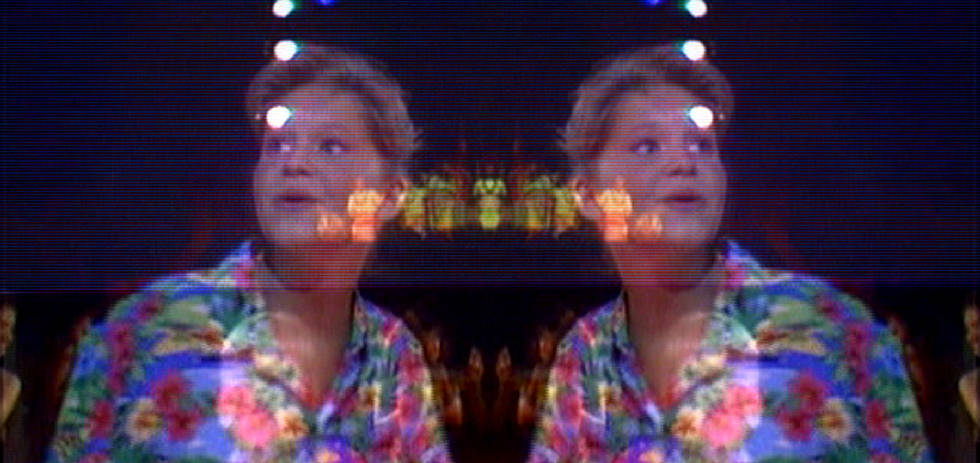
In Hammers, Isis/Elizabeth and Horus/Michael are inextricably linked, like Alexis and Krystle in The Dark, Krystle or even the Tanners and whatever ancient supernatural force is inhabiting them in Light is Waiting. As Cleopatra says, “As if living had been just a dream, someone else’s dream.” Can you talk a little about this idea of souls being linked in your films, the idea that the characters are living in each other’s dreams? What keeps you coming back to this?
I haven’t thought of it in quite those terms, but that’s a nice way to describe it—witnessing and feeling implicated in someone else’s dreams. The attachments and motivations between people, place and times are all fluid like in a dream. And as in dreams, the characters are subject to the instabilities of the film, and are often made to reckon with its obtuse logic. The woman collecting firewood in The General Returns looks out at the audience in bewilderment as though she were reacting to the swelling bass sound that swallows her otherwise serene leitmotif. Krystle/Linda Evans whimpers “what’s happening?” to herself as the montage of her sorrows picks up in intensity and Alexis’s voiceover becomes more aggressive. Their characters are part of my film, but also part of another film, another time, and another existence. The resulting disorientation and tension allows for the woozy, ghostly intermingling of different personas and voices, blurring the lines between them so their essences are left floating, open to rearrangement.
Transformation feels like a huge part of your work. It’s physical in a formal sense—that you’re pulling together disparate material to create new stuff—but also psychically, in that souls seem to transmigrate, which reminds me a lot of later David Lynch. Is there something that draws you to the idea of transformation?
Who doesn’t like a good transformation? I’m usually drawn towards materials that I have a somewhat conflicted relationship to, whether it’s the easy nostalgia of 16mm film, or the baroque stylisation of a dumb TV sitcom. I don’t see my films transforming their materials so much as refracting or skewing them, so that we might experience them in a different light or see through them to reveal what they are hiding. But there is definitely an element of cultural exorcism to a lot of my films, which is an inherently transformative pursuit. By running the gauntlet of its characters’ repeated actions, The Dark, Krystle attempts to free Krystle and Alexis (or maybe Linda Evans and Joan Collins) from their oppressive soapy stereotypes, even though the action of the film suggests they are eternally trapped and tying to kill each other. The souls of M.J./Horus and Elizabeth/Isis reach their afterlife in the flickering ice dance finale of These Hammers Don’t Hurt Us, and the demons of Full House and Final Cut Pro are exorcised, or at least quieted by the end of Light Is Waiting.
Most commentary on your work talks about your reconfiguring of pop material, which makes it superficially at least the perfect art for the “Internet Age” (whatever that is.) But what distinguishes it for me is that it’s not framing the sources as junk: your films extract the beauty of the original work—even where it might not be initially apparent. What is it that attracts you to that “beauty” in these things?
That’s hard to pin down, as beauty is shifty and rarely just itself. But in general, I try to treat all of media history with a kind of equivalence—nothing is really above anything else—such that everything from Classic Hollywood to YouTube vlogging can be experienced as potentially profound or stupid; usually both. Unraveling that notion of equivalence across a range of materials feels exciting to me. I’m often drawn towards aesthetic excess, or camp, because it’s a seductive and joyful place from which to begin, with something very serious bubbling just beneath the surface—some base reality that has already been exaggerated and decorated with meaning. So, Joan Collins’ 1980s hairdos and outfits are of course amazing, because they are outrageous and dated and therefore sort of funny, but when hundreds of them flash in front of you, attached to her human being, the parts of the machine can be seen or felt individually—person, character, style, color, material, time—and the ideas behind the surface can seep out: capitalism, sexism, Ronald Reagan, AIDS, feminism, entertainment, etc. That wouldn’t work if the excesses of style and overacting weren’t already in place—they are the original “work” that allows for a productive re-visiting.
Part of making things beautiful is also taking care in how they are used, which is to say, I spend a great amount of time fine-tuning the image quality, pacing and sound design of my films, and they often feel like junk until they’re nearly done, when things fall into a harmony of sorts.
There’s a scene I’ll never forget in (Jim Henson’s) The Dark Crystal in which the Skeksis and Mystics merge in a blinding flash, darkness and light becoming one and the same. I’m going ask, perhaps stupidly: Was this moment at all formative for you as kid?
Maybe. I love that movie, and though it wasn’t something I watched endlessly, it has always stuck with me, particularly the Skeksis and Mystics, and the great noises they make. I watched it a few months ago, and it still holds up so well, where many fantasy film of that era don’t, like The NeverEnding Story or Flight of the Navigator.
What was the first thing you remember being drawn to, pop-culture wise, in the sense that you were maybe aware of something “sublime” going on beneath (or on) the surface?
I was a rabid fan of Pee-Wee’s Playhouse, and remember being completely awestruck by a moment in one episode when Pee-Wee breaks the fourth wall in a way I was not expecting. Throughout the series, whenever any character says they love something, Pee-Wee almost always replies “Why don’t you marry it?!” In this episode, Pee-Wee makes a bowl of fruit salad, and after taking a bite, declares that he loves it. On cue, I said to the television, “Why don’t you marry it?” Pee-Wee turns to the camera, pauses, and says “Alright then… I will.” I was floored. It was like the hand of God came through the TV and picked my nose. The playhouse then holds a wedding ceremony for Pee-Wee and the bowl of fruit salad, which wears a long white veil to the ceremony… genius.

Talking about Hammers, you said that you “began to consider online archiving and viewing as a kind of mummification,” an “undead shell to be played and replayed forever, shrouded in digital gauze.” Is there a danger of culture losing the context of the original work completely, or is it—as the characters in Circle in the Sand say (“Destroy knowledge, but from within knowledge”)—a good thing?
I don’t know… but I would place my bets on danger. It’s so strange to think how little video content was online just 10 years ago, and now we have essentially come to expect to find video record of anything that ever happened on YouTube, or through a few quick searches elsewhere. The change in viewing context for something like a music video doesn’t bother me, and seems more productive and less corrosive than watching MTV for hours waiting for the one video you want to see. But the Internet’s flattening of time, history and experience feels mummifying to me. I do think it’s killing off a significant portion of our collective imagination and intellect, and in another 10 or 20 years we will be reckoning with some severe social and mental changes. As things “progress” from here, I think film and television will be fine, as we can ingest those from our multiplying personal screens, so the demand and infrastructure for high-quality moving-image entertainment is only going to grow. But as for people remembering how to interact with each other, leave their homes, think or read… we may be in trouble. The numb and the restless.
Does culture, through YouTube or the endless loop of old images/videos/sounds on the Internet, risk romanticising our memory of pop culture to the point of oblivion? Is it just “Shattered glass shining in a perfect heap”?
Ask me again in 10 years, if I still have the capacity to speak. It does seem like the processing of culture has been sped up and churned into an endless feedback loop, from which we may never really escape. Part of me wants to think the next generation will be better off, that kids being born into a hyper-connected digital universe will be able to utilize it all in a way that makes society smarter, kinder, and less anxious, but that’s probably wishful thinking.
Does the “supercut” culture interest you at all, as a cultural phenomenon or whatever?
Not really. I mean, there’s honestly not that much of it I’ve ever knowingly encountered. I like the Don Draper Says “What” one but then there’s a whole world of BuzzFeed garbage or “Teens React” videos which have largely co-opted the term. Artists were making this type of work long before the Internet and the best “supercuts” I know of are all made by filmmakers for screening or installation contexts: Jesse McLean’s Somewhere Only We Know, Matthias Müller’s Home Stories, several of Mike Olenick’s films. Also, if Don Draper Says “What” was included in an experimental film festival, it wouldn’t be out of place. A friend told me after seeing The Dark, Krystle that he didn’t know what to make of it, because he liked it so much but then realized it was just a supercut (coincidentally, he was struck in the face with a Ming vase full of burning champagne just moments later). I think the term originated as something a bit more specific, but now, any montage made for online viewing can be called a supercut. The numerous fan edits of The Force Awakens trailer, which merge the various official trailers, are all labeled as supercuts. I appreciate that these types of videos exist and get watched by millions, but I can’t say I’m that interested or invested.
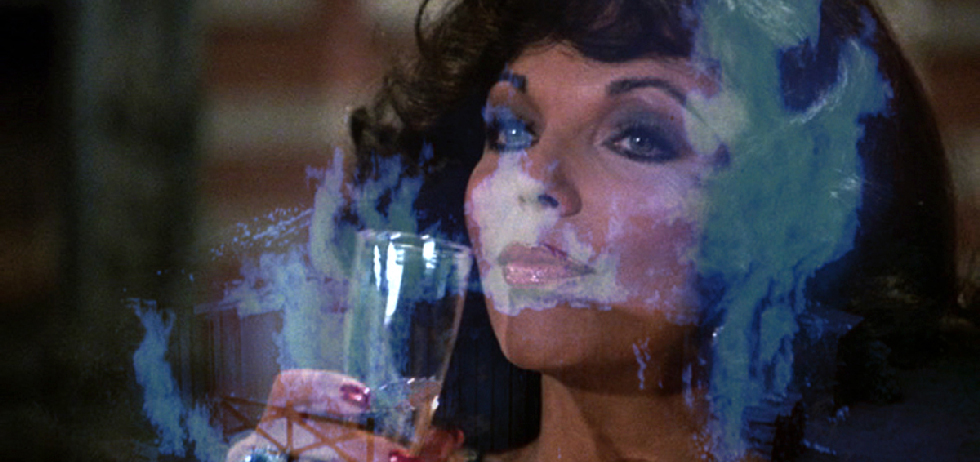
In Cinema Scope you said your recent films were “less interested in antagonizing their source materials so much as reconfiguring them.” How did your approach change? What made you less antagonistic?
That was a while ago now, but I think I got over some things when the US managed to elect a decent human being as a president. The George W. Bush years just felt hopeless and awful in America. You Don’t Bring Me Flowers, And We All Shine On, The General Returns, and Victory Over the Sun were all hell-bent on extracting a kind of experiential evil from the American landscape. The dangers of manipulation and seduction were at the forefront of those films, and that was a really productive path for me to follow, but after finishing Victory Over the Sun (the angriest of the bunch) I felt I’d gotten something out of my system. I still get a lot of my inspiration from anger and doom, but the films themselves are less antagonistic.
Are there any contemporary narrative filmmakers you admire or identify with?
Absolutely. In many ways, I feel like I get the majority of my inspiration from filmmakers working in and experimenting with narrative. Apichatpong Weerasethakul, Claire Denis, Miguel Gomes, Kelly Reichardt… (that’s) maybe a somewhat obvious list of independent film all-stars, but theirs are the films that affect me the most and stay with me the longest. Spring Breakers, Uncle Boonmee, White Material, Tabu, Meek’s Cutoff—all total knockouts in my book. Paul Thomas Anderson remains amazing to me; the consistency of his films is insane at this point. But they are so good as to almost be discouraging—I adore them but I don’t identify as much, as they seem out of reach. I also get inspired by the rage induced by seeing critically-hyped films that I end up rolling my eyes through; Upstream Color and Holy Motors are at the top of my recent revenge list.
Where do you find day-to-day inspiration for your work? You’ve indicated that the films form over many hours of sifting through materials, but where is the germ of the idea born? Like, say, Circle in the Sand—what’s the spark for something like that?
To call it day-to-day inspiration would maybe be a misnomer, as I have plenty of days with zero inspiration, and real sparks are hard to come by. For Circle in the Sand, the initial germ came from my getting to spend a lot of time wandering around a beach in Northern California, where the film was eventually shot. I was at a residency nearby for a few months in 2009, and tried to get myself to the beach every day. It’s a weirdly hard-to-reach spot, despite being fairly close to San Francisco, so is often empty, save for occasional naked older men keeping watch behind boulders, suspicious looking teenagers, and pelicans. The cliffs are dotted with the abandoned, concrete structures of a former military battery, so the whole place has a haunted, but blissful, Planet of the Apes vibe. Many of the details and scenarios of Circle in the Sand originated as notes or sketches taken down while sitting on that beach. And the rest of the film fleshed itself out in response to the cloud of apathy and self-destruction that seems to overtake America every few years (particularly, seeing the public rally against their own well-being in rejecting the possibility of socialised healthcare in 2009). For my found-footage films, the spark occurs more by happening upon an initial piece of material and recognizing its potential for repurposing, or by hearing a song at the right moment and having a fleeting mental image of how it could work in a film. I have a lot of scattered notes of song titles, sometimes with vague directions like “beegees – if i can’t have you – ending stretched forever”.
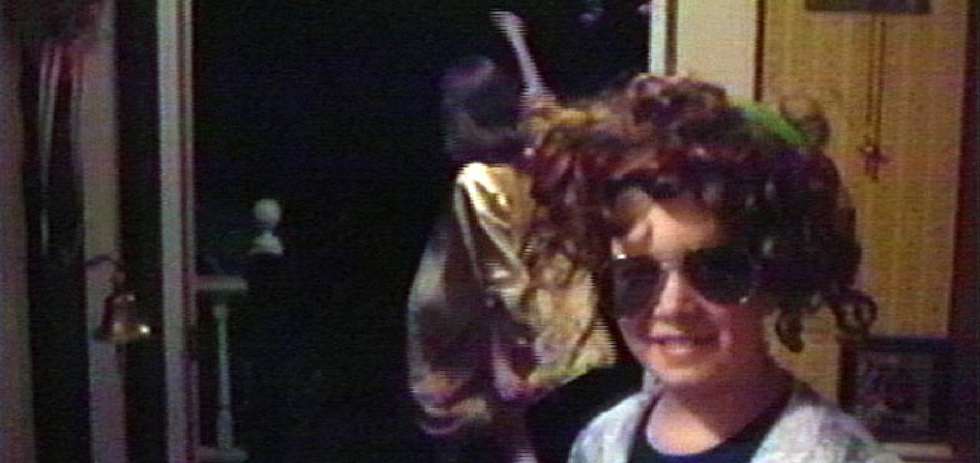
You’ve talked a little about Twin Peaks and Nintendo being influential childhood experiences. What else inspired you as a kid? There’s that scene in Chiquitita and the Soft Escape, for example, that perfectly captures the fascination with the VHS pause button that many of us share as kids I think.
I grew up in a very rural corner of NY state, and was always inspired by my older sister, who appears in both Chiquitita and Carol Anne is Dead. She was the social director of our little world, and most of our playing included some type of performative collaboration. We had specific dance routines to a number of songs, and Chiquitita and the Soft Escape is partially named for the ABBA hit (for which I played a shy fairy, hiding under a chair, while my sister played an exuberant fairy, who coaxes me into frolicking with her in the world beyond the chair). Watching movies and TV together was a constant, and like most kids of the ’80s, we would view the same handful of VHS tapes over and over again. Our heaviest repeaters included Romancing the Stone, Star Wars, Splash, Moonstruck, Anne of Green Gables, Pee-Wee’s Big Adventure, and The Secret Garden. We did try to pause certain tapes at key moments, like when the green ghost flies at the camera in the final shot of Ghostbusters, or the split second of Three Men and a Baby when the alleged dead boy appears in the window.
Moving into adolescence, music became really influential to me, as did literature. Lord of the Flies enthralled me in 9th grade. I had such a clear and cinematic mental image of every scene that I was totally frustrated by both movie versions for falling short of how I’d imagined it. That was probably the first time I thought about filmmaking as an outlet of visualization. Between the ages of 12 and 16 I also had some formative experiences at a very lovey-dovey Catholic summer camp, which involved lots of hugging, holding hands in group circles, and singing emotionally-triggering soft rock songs together while staring out a beautiful landscape… duh.
Given you remade Poltergeist as a kid (I love your Zelda Rubenstein impression, by the way), how important was this film—and its obsession with menacing TV static and ghostly optical effects—on shaping your young sensibility (if at all)?
Not that important, actually. To my memory, we only rented it once, and made our video immediately afterwards. I don’t recall writing anything down as we watched the film, so the “script” we were using was mostly from recall. We had just gotten a VHS camcorder, and were really excited to play with it, so we would have likely reenacted whatever movie we’d brought home. We made a number of other videos around the same time, most of which also deployed the same curly red wig and southern accent—probably inspired by Designing Women and The Golden Girls. But we did like Poltergeist, and the image of the kid using the television set as a supernatural interface is still pretty haunting.
Would you ever move to make—or remake—a narrative feature, and how would you approach it?
I’m actually embarking on doing just that. I’ve been slowly writing a narrative feature over the past few years and am just starting to get the ball rolling forward with it. The film is called I’ll Be Thunder, and it’s a psychodrama centering around a family running a guesthouse on a remote tropical island. It’s going to be dark and funny and beautiful. I was awarded a Creative Capital grant for the project in 2012, as a counterpart to Circle in the Sand, though it has grown and changed since then to become its own, separate project. It’s now a proper feature, with dialogue, actors, crew and all the thrilling nightmares that come with starting a small business. My friend and American filmmaker extraordinaire Matt Porterfield is producing the film, which I’m very happy about. We’re currently looking into funding possibilities, and are hopeful we can shoot before the end of 2016. I’m excited and terrified by the whole thing, but that seems about right.
To explore more of Robinson’s film and video work, visit his site, Poison Berries, or his Video Data Bank page.
